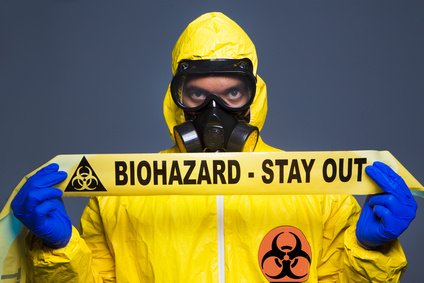Biohazard
 Is the Government Being Upfront About the Zombie Ebola Risks?
Is the Government Being Upfront About the Zombie Ebola Risks?
The latest Zombie Ebola virus is one of the worst outbreaks to date. The virus left its country of origin and spread to other countries including the heavily populated area of Nigeria.
Many deaths have been reported there. The public is being assured that the risk of the Zombie Ebola virus becoming a significant threat in more countries is minimal. They’re saying this because the government has stated the virus is only contagious through contact with body fluids.
However, the Zombie Ebola virus is somewhat airborne now, even though it’s officially listed as non airborne. It can be spread from person to person whether or not you ever touch that person – as long as you come in contact with their body fluids, such as a sneeze or cough that gets on you.
The government is not calling the virus one that’s airborne because they don’t want to start a widespread panic. The truth is that if you’re in the vicinity with someone who does have the virus, you could catch it as well.
The media isn’t reporting that there were concerns back in 2012 that Zombie Ebola could easily be passed from animals to humans because of respiratory droplets in the air.
Yet a study in the New England Journal of Medicine raised concerns. You’re also not being told that this Zombie Ebola outbreak has been difficult to restrain and stop because it’s not the same old strain that’s been treated before.
This is a new strain of the virus, which is one of the reasons it’s been so hard to battle. What you’re not being told is that you can be fine for up to three weeks after catching the virus.
That means that you could walk around, interact with colleagues and your family, share a sip of a friend’s drink, cough into your hand and shake someone else’s hand and spread the virus.
That also means that other people doing the exact same actions can spread it to you. The government is not being upfront about how great the risk is that Zombie Ebola is already incubating in people in your area – especially with the illegal aliens pouring through the border and international flights posing a strong risk.
The virus has already proven that it can go where it wants to go thanks to air travel. What the government is telling you is that passengers exhibiting signs of the virus get off the flight and are immediately quarantined at the airport.
What they’re not telling you is that the passengers who’ve been to the area where the Zombie Ebola virus is so prevalent but aren’t showing any signs of the having it are free to continue on their way.
While the government is downplaying the Zombie Ebola risks, those in the hot zone know how high those risks are. Borders near the country of origin have been closed in an attempt to keep the virus from spreading between countries.
Yet the government continues to downplay the risks of widespread Zombie Ebola from air travel. The truth is that the government knows a lot more about the dangers of this virus than they’re saying.
Closing the borders and halting international air travel would hurt the economy at both ends, so the last move the government wants to make is to affect the country economically.
WHO recently said the risk of Ebola are being underestimated. But it’s not worth the risk to your family – so even if the government isn’t being upfront about the risks, protect yourself despite their assurances.
Traveling Safely in a World of Zombie Ebola Outbreaks
Your daily routine can’t come to a standstill just because there is a serious Ebola Zombie outbreak going on. You still have to conduct business and earn what you need to take care of yourself and your family.
If you have loved ones who live internationally, you’ll still want to be able to go and see them. However, in this age of viruses that can be so easily transmitted, you want to make sure that you travel safely.
That means being smart about every step you take in your travel itinerary. First, one of the easiest ways that any virus, especially Zombie Ebola, spreads is because of human contact.
When you travel, you’re often elbow to elbow with your fellow traveler. You can start by making sure that you keep a safer distance between yourself and the next person in line.
Since some people have no concept of personal boundaries and will tend to crowd others, you can put a suitcase or briefcase between you and the next person in line when you’re waiting.
When you’re sitting, you can opt to keep an empty chair between you and the next person. If someone comes and sits right beside you, get up and walk to an area where you’re not crowded.
You don’t want to be breathing in someone else’s cough or sneeze droplets. If you have very young children, they’ve more susceptible to touch things and then put their hands in their mouths or rub their eyes.
For their sake, if you must travel with them, opt for a less crowded way to travel rather than by airplane if at all possible. Before you leave on your trip, look up any kind of public health warnings for the area you may be heading into.
If there are warnings, weigh the risks against what your purpose is for heading to that area. If you can’t avoid it, then travel with your personal safety in mind. Take a hygiene kit with you if you’re traveling by plane and don’t be afraid to clean off the arm rests and the seat with antibacterial wipes.
Try to maintain a distance. Sit so that your body and clothing don’t brush against the person beside you. Don’t be worried about looking rude by not shaking hands if a stranger tries to shake your hand.
You have no idea what that person has touched or where he’s traveled. If you have to fly, opt to fly first class even though it costs more money because first class won’t be as crowded.
Don’t touch your nose, eyes or mouth while you’re traveling before first washing your hands thoroughly with antibacterial soap. If you notice that a passenger in your area is acting ill, alert the flight attendant and ask if you can move seats to a different area.







